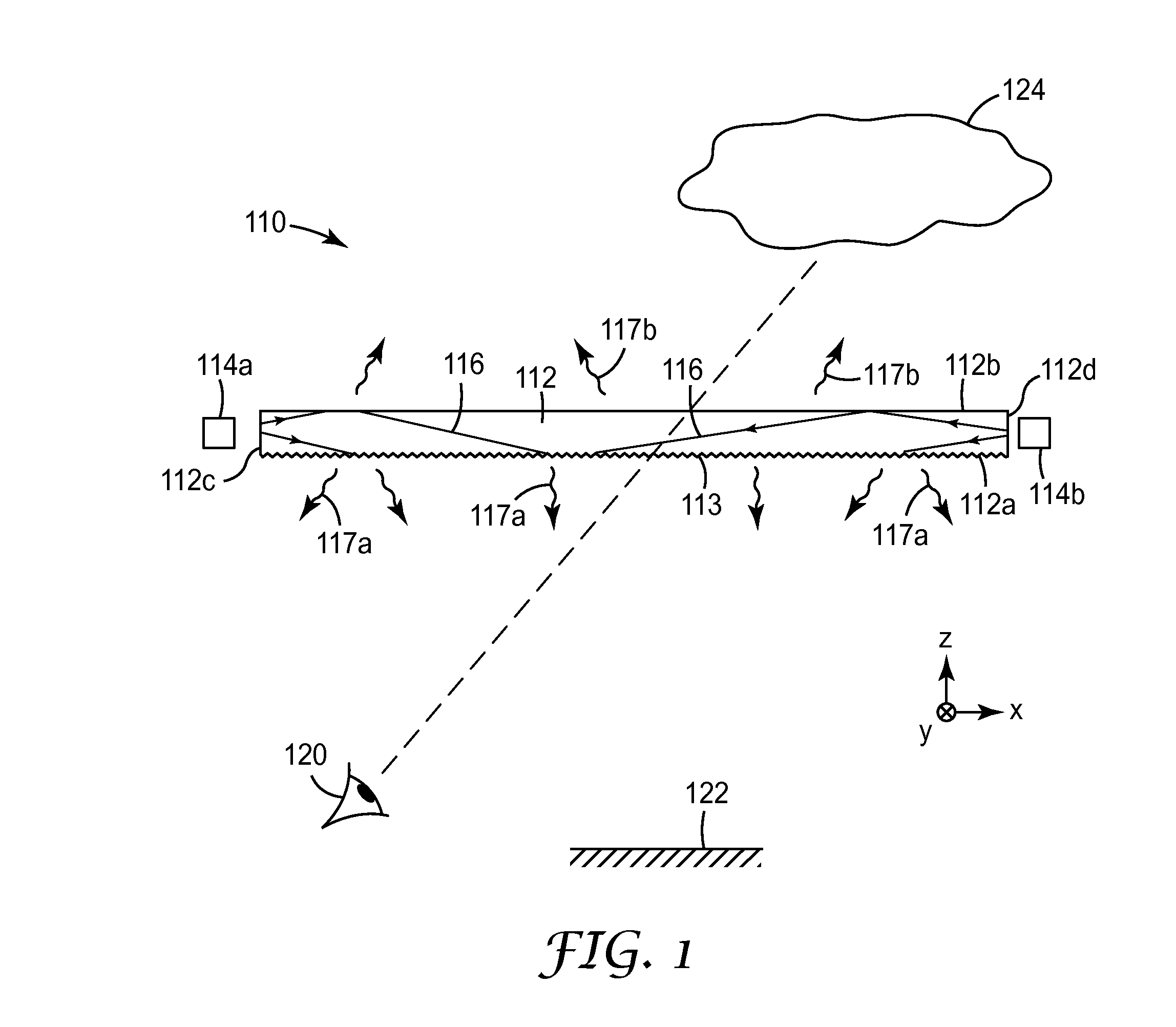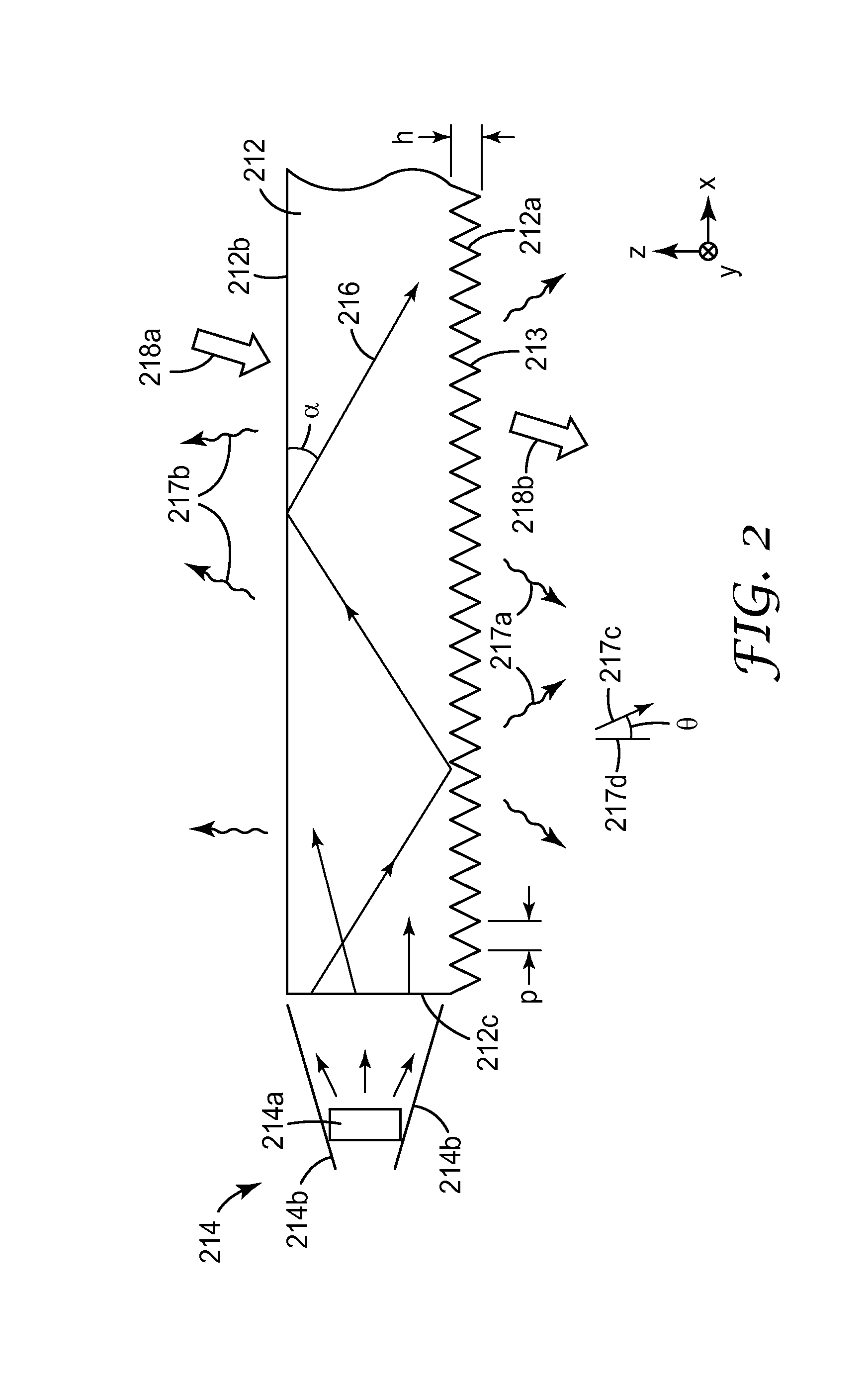Diffractive lighting devices with 3-dimensional appearance
- Summary
- Abstract
- Description
- Claims
- Application Information
AI Technical Summary
Benefits of technology
Problems solved by technology
Method used
Image
Examples
example 1
[0131]A lighting device suitable for use as a luminaire was made and evaluated. The device was similar in design to that of FIGS. 14, 15a, and 16. The device incorporated a circular-shaped light guide with diffractive surface features in the form of a spiral pattern, the diffractive surface features arranged into repeating patterns of six packet types with different groove or prism pitches. A mounting ring was used to position thirty-six equally spaced LEDs around the curved side surface of the light guide to inject light into the light guide. Further details of construction will now be given.
[0132]A precision diamond turning machine was used to cut a spiral-shaped groove pattern, which became the diffractive surface features in the lighting device after replication, into the copper surface of a cylindrical tool. The diamond was shaped so that the grooves had a sawtooth (asymmetric) profile in cross section similar to FIG. 6, with a height-to-pitch ratio (see FIG. 6) of about 1:1. D...
example 2
[0147]A lighting device was made as described in connection with FIGS. 21 through 22c. The device used rectangular piece 2121 (see FIG. 21), and the light source module 2214 was mounted along the short side of the light guide as shown in FIG. 22b, along the TE edge of the rectangular piece 2121. The light sources were energized with a power supply and photographs were taken of the lighting device from various viewing geometries. A photograph of the lighting device when viewed substantially along the optical axis 2201 (see FIGS. 22a, 22b) is shown in FIG. 23a. The light sources and the TE edge of the piece 2121 are on the left side of this figure. A photograph of the same lighting device when viewed at an oblique angle in the y-z plane is shown in FIG. 23b. The light sources and the TE edge of the piece 2121 are at the top of this figure. A photograph of the same lighting device when viewed at an oblique angle in the x-z plane is shown in FIG. 23c. The light sources and the TE edge o...
example 3
[0148]Another lighting device was made as described in connection with FIGS. 21 through 22c. The device used rectangular piece 2122 (see FIG. 21), and the light source module 2214 was mounted along the short side of the light guide as shown in FIG. 22b, along the TE edge of the rectangular piece 2122. The light sources were energized with a power supply and photographs were taken of the lighting device from various viewing geometries. A photograph of the lighting device when viewed substantially along the optical axis 2201 (see FIGS. 22a, 22b) is shown in FIG. 24a. The light sources and the TE edge of the piece 2122 are on the left side of this figure. A photograph of the same lighting device when viewed at an oblique angle in the x-z plane is shown in FIG. 24b. The light sources and the TE edge of the piece 2122 are on the left side of this figure. A photograph of the same lighting device when viewed at another oblique angle in the x-z plane is shown in FIG. 24c. In this figure, th...
PUM
 Login to View More
Login to View More Abstract
Description
Claims
Application Information
 Login to View More
Login to View More - R&D
- Intellectual Property
- Life Sciences
- Materials
- Tech Scout
- Unparalleled Data Quality
- Higher Quality Content
- 60% Fewer Hallucinations
Browse by: Latest US Patents, China's latest patents, Technical Efficacy Thesaurus, Application Domain, Technology Topic, Popular Technical Reports.
© 2025 PatSnap. All rights reserved.Legal|Privacy policy|Modern Slavery Act Transparency Statement|Sitemap|About US| Contact US: help@patsnap.com



